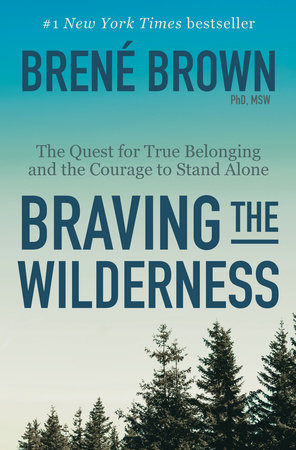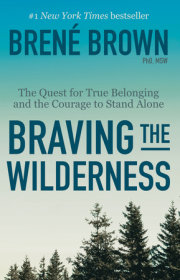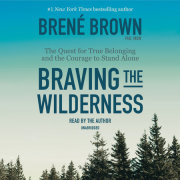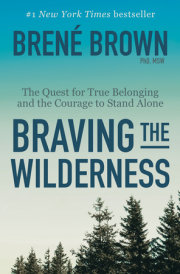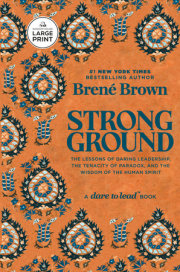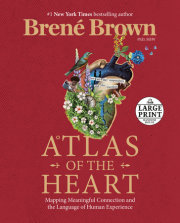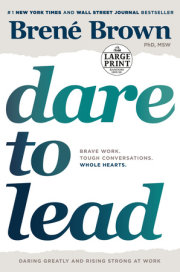ONE
Everywhere and Nowhere
When I start writing, I inevitably feel myself swallowed by fear. And it’s especially true when I notice that findings from my research are going to challenge long-held beliefs or ideas. When this happens, it doesn’t take long before I start thinking, Who am I to say this? Or, I’m really going to piss people off if I call their ideas into question.
In these uncertain and risky moments of vulnerability, I search for inspiration from the brave innovators and disrupters whose courage feels contagious. I read and watch everything by them or about them that I can get my hands on—every interview, every essay, every lecture, every book. I do this so that when I need them, when I’m living in my fear, they come to sit with me and cheer me on. Most important, while watching over my shoulder, they put up with very little of my bullshit.
Developing this process took time. In my earlier years, I tried the opposite approach—filling my mind with critics and naysayers. I would sit at my desk and picture the faces of my least favorite professors, my harshest and most cynical colleagues, and my most unforgiving online critics. If I can keep them happy, I thought, or at the very least quiet, I’ll be good to go. The outcome was the worst-case scenario for a researcher or a social scientist: findings that were gently folded into a preexisting way of seeing the world; findings that carefully nudged existing ideas but did so without upsetting anyone; findings that were safe, filtered, and comfortable. But none of that was authentic. It was a tribute.
So I decided that I had to fire those naysayers and fearmongers. In their places, I began to summon up men and women who have shaped the world with their courage and creativity. And who have, at least on occasion, pissed people off. They are a varied bunch. J. K. Rowling, author of the Harry Potter books I love so much, is my go-to person when I’m struggling with how to introduce a new and strange world of ideas that has only just emerged from my research. I imagine her telling me: New worlds are important, but you can’t just describe them. Give us the stories that make up that universe. No matter how wild and weird the new world might be, we’ll see ourselves in the stories.
The author and activist bell hooks comes to the fore when there’s a painful conversation happening around race, gender, or class. She’s taught me about teaching as a sacred act and the importance of discomfort in learning. And Ed Catmull, Shonda Rhimes, and Ken Burns stand behind me, whispering in my ear, while I’m telling a story. They nudge me when I become impatient and start skipping the details and dialogue that bring meaning to storytelling. “Take us with you into that story,” they insist. Countless musicians and artists also show up, as does Oprah. Her advice is tacked to the wall in my study: “Do not think you can be brave with your life and your work and never disappoint anyone. It doesn’t work that way.”
But my oldest and most steadfast counselor is Maya Angelou. I was introduced to her work thirty-two years ago when I was studying poetry in college. I read her poem “Still I Rise” and everything shifted for me. It contained such power and beauty. I collected every Angelou book, poem, and interview I could find, and her words taught me, pushed me, and healed me. She managed to be both full of joy and unsparing.
But there was one quote from Maya Angelou that I deeply disagreed with. It was a quote on belonging, which I came across when I was teaching a course on race and class at the University of Houston. In an interview with Bill Moyers that aired on public television in 1973, Dr. Angelou said:
You are only free when you realize you belong no place—you belong every place—no place at all. The price is high. The reward is great.
I can remember exactly what I thought when I read that quote. That’s just wrong. What kind of world would it be if we belonged nowhere? Just a bunch of lonely people coexisting. I don’t think she understands the power of belonging.
For over twenty years, whenever that quote popped up in my life, I felt a rush of anger. Why would she say that? That’s not true. Belonging is essential. We must belong to something, to someone, to somewhere. I soon realized that the anger came from two places. First, Dr. Angelou had come to mean so much to me that I just couldn’t stand the thought that we disagreed on something so fundamental. Second, the need to fit in and the ache of not belonging was one of the most painful threads in my own life. I couldn’t accept the idea of “belonging nowhere” as freedom. Feeling like I never truly belonged anywhere was my greatest pain, a personal suffering that threaded through most of my pre-adult life.
It was in no way my liberation.
Experiences of not belonging are the time markers of my life, and they started early. I attended pre-K and kindergarten at Paul Habans Elementary on the west bank of New Orleans. It was 1969, and as wonderful as the city was and still is, it was a place suffocated by racism. Schools had only become officially desegregated the year I started. I didn’t know or understand much about what was happening, I was too young; but I knew that my mom was outspoken and tenacious. She spoke up a lot and even wrote a letter to the Times-Picayune challenging the legality of what today we’d call racial profiling. I could sense that energy around her, but to me, she was still just a volunteer in my homeroom and the person who made me, herself, and my Barbie matching yellow plaid shift dresses.
We had moved there from Texas, and that had been hard for me. I desperately missed my grandmother, but I was eager to make new friends at school and around our apartment complex. It quickly got complicated, though. Homeroom lists were used to determine everything—from attendance records to birthday party invitations. One day my mom’s room-mother partner waved the list in front of my mom’s face and said, “Look at all of the black kids on here! Look at these names! They’re all named Casandra!”
Huh, my mom thought. Maybe this explained why I was being left out of so many of my white friends’ parties. My mom goes by her middle name, but her first name is Casandra. My full name on that homeroom list? Casandra Brené Brown. If you’re African American and reading this, you know exactly why white families weren’t inviting me over. It’s the same reason a group of African American graduate students gave me a card at the end of the semester that said, “OK. You really are Brené Brown.” They had signed up for my course on women’s issues and almost fell out of their chairs when I walked to my desk at the front of the classroom on the first day of class. One student said, “You are not Casandra Brené Brown?” Yes, ma’am. It’s also why, when I walked into a job interview for a part-time receptionist at a doctor’s office in San Antonio, the woman said, “You’re Brené Brown! Well, what a pleasant surprise!” And yes, I walked out of the interview before we sat down.
The black families were welcoming to me—but their shock was noticeable when I walked through the door. One of my friends told me I was the first white person who had ever been inside their house. That’s hard to wrap your head around when you’re four years old and you’re really there for pin-the-tail-on-the-donkey and to eat cake with your friends. As simple as belonging should be in kindergarten, I was already struggling to understand why I felt on the outside of every group.
The next year we moved to the Garden District so my dad could be closer to Loyola, and I transferred into Holy Name of Jesus. I was an Episcopalian, which made me one of the only non-Catholic students in my school. Turned out I was the wrong religion, yet another wedge between me and belonging. After a year or two of sitting out, being called out, and sometimes being left out, I was sent to the office, and arrived to find God waiting for me. At least that’s who I thought it was. It turned out to be a bishop. He handed me a mimeographed copy of the Nicene Creed and we went through it, line by line. When we were done, he handed me a note to take home to my parents. The note read, “Brené is Catholic now.”
Still, things were relatively good for the next couple of years as I started to get into the groove of my new life in New Orleans, mostly because I had the best BFF in the world—Eleanor. But then came a bunch of big moves. We left New Orleans for Houston when I was in fourth grade. Then we left Houston for Washington, D.C., when I was in sixth grade. Then we left Washington when I was in eighth grade and moved back to Houston. The normal turbulence and awkwardness of middle school was magnified by perpetual “new-girl-ness.” My only saving grace was that during all of these transitions, my parents were in a good place and getting along. This meant that despite the turbulence around me with ever-changing schools, friends, and adults, home was safe. It even felt like a refuge from the pain of not belonging. When all else failed, I belonged at home, with my family.
But things started to break. That last move back to Houston was the beginning of the long, miserable end to my parents’ marriage. And right on top of that chaos, there were the Bearkadettes.
When we moved back to Houston at the very end of eighth grade there was, thankfully, just enough time to try out for the high school drill team, called the Bearkadettes. This was to be my everything. In a house that was increasingly filled with the muffled sounds of my parents arguing, heard through the walls of my bedroom, that drill team was salvation. Just picture it: lines of girls in white-fringed blue satin vests and short skirts, all of them wearing uniform wigs, white cowboy boots, small white cowboy hats, and bright red lipstick, strutting into high school football stadiums filled with crowds afraid to leave their seats during halftime lest they miss the high kicks and perfectly choreographed routines. This was my way out, my new, pretty, impeccably ordered refuge.
Eight years of ballet was plenty to get me through the task of learning the routine, and a two-week liquid diet got me through the brutal weigh-in. All of the girls swore by the cabbage soup and water diet. It’s hard to think of letting a twelve-year-old go on a liquid diet, but for some reason it seemed normal.
To this day, I’m not sure I’ve ever wanted anything in my life more than I wanted a place on this drill team. The perfection, precision, and beauty of it would not only offset the growing turmoil at home, but also deliver the holy grail of belonging. I would have a “big sis” and she would decorate my locker. We’d have sleepovers and date football players. For a kid who had seen Grease forty-five times, I knew this was the beginning of a high school experience that included sudden, spontaneous sing-alongs and the 1980s version of sock hops.
And most of all, I would be a part of something that literally did everything together in lockstep. A Bearkadette was belonging personified.
I didn’t really have any friends yet, so I was on my own for tryouts. The routine was easy to learn—a jazzy number performed to a big band version of “Swanee” (you know, the “how I love ya, how I love ya” one). There was a lot of sliding with jazz hands and an entire section of high kicks. I could kick higher than all of the girls except one dancer named LeeAnne. I practiced so much that I could do that routine in my sleep. I still remember parts of it today.
Tryout day was terrifying, and I’m not sure if it was my nerves or the starvation diet, but I was lightheaded when I woke up, and I stayed that way after my mom dropped me off at the school. Now, as the mother of a teen and a tween, it’s a little hard to think of how I had to walk in by myself, surrounded by groups of girls who were piling out of cars and running in together, holding hands. But I soon realized I had a bigger problem than walking in alone.
All of the girls—and I mean all of the girls—were made up from head to toe. Some were wearing blue satin shorts and gold shirts, and others had blue and gold tank tops with little white skirts. There was every iteration of blue and gold bows that you could imagine. And they were all in full makeup. I had on no makeup, and I was wearing gray cotton shorts over a black leotard. No one had told me that you were supposed to get decked out in school colors. Everyone looked so bright and shiny. I looked like the sad girl whose parents fight a lot.
I made the weigh-in with six pounds to spare. Even so, the sight of girls stepping off the scale and running into the locker room weeping traumatized me.
We wore numbers safety-pinned to our shirts and danced in groups of five or six. Lightheaded or not, I nailed the routine. I felt pretty confident when my mom picked me up and I went home to wait it out. They would post the numbers later that evening. Those hours in between moved in slow motion.
Copyright © 2017 by Brené Brown. All rights reserved. No part of this excerpt may be reproduced or reprinted without permission in writing from the publisher.

